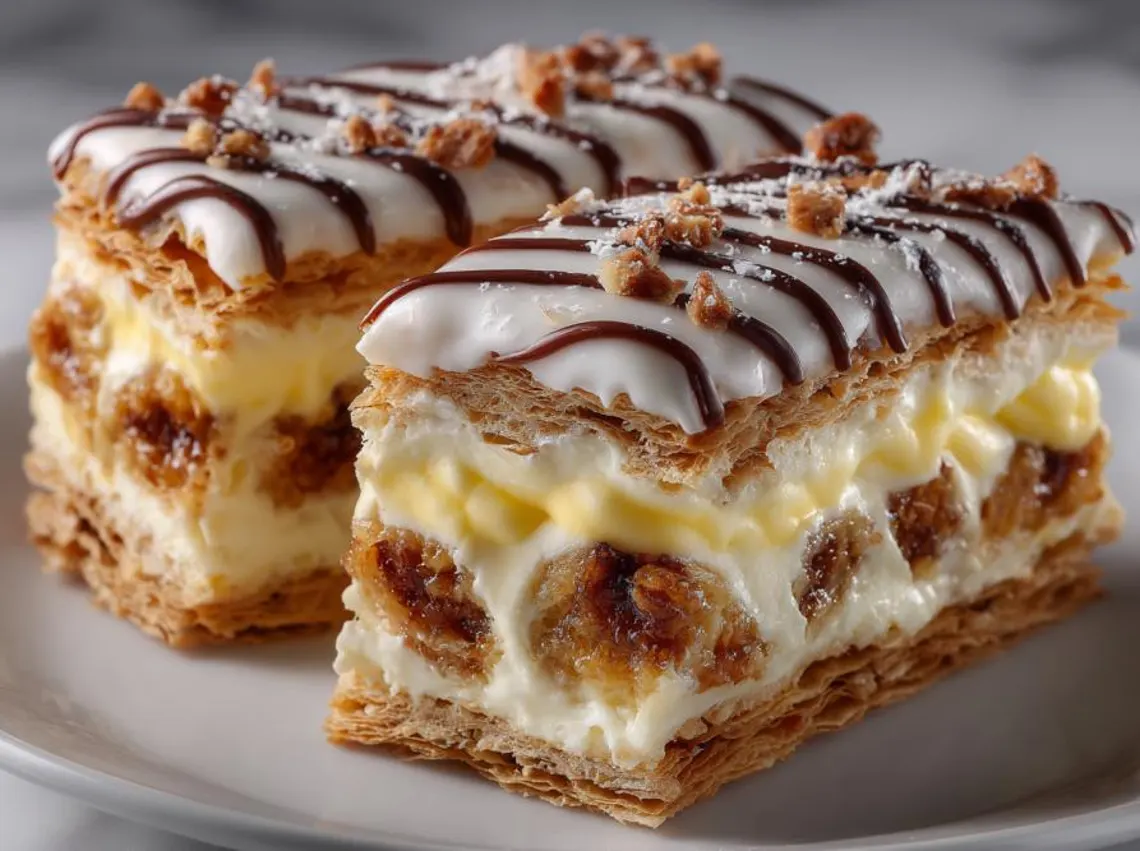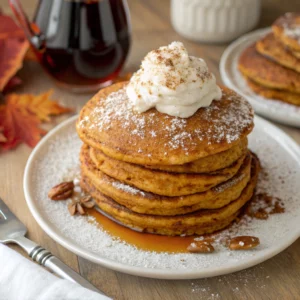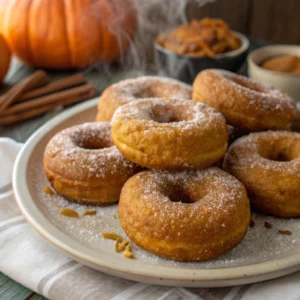Have you ever wondered how pastry chefs create those perfectly layered, crispy yet creamy desserts that seem impossible to recreate at home? The secret might be simpler than you think. With the right technique and a bit of patience, you can master the iconic Mille-Feuille Pastry Recipe right in your own kitchen.
This classic French desserts (also known as Napoleon) features delicate layers of puff pastry separated by rich pastry cream and topped with a distinctive marbled icing. Though it looks intimidating, breaking it down into simple steps makes this elegant treat achievable for home bakers.
The name “mille-feuille” translates to “thousand leaves,” referring to the many delicate, flaky layers created during the baking process. Let’s dive into this timeless recipe that has graced French patisseries for centuries.
Ingredients List
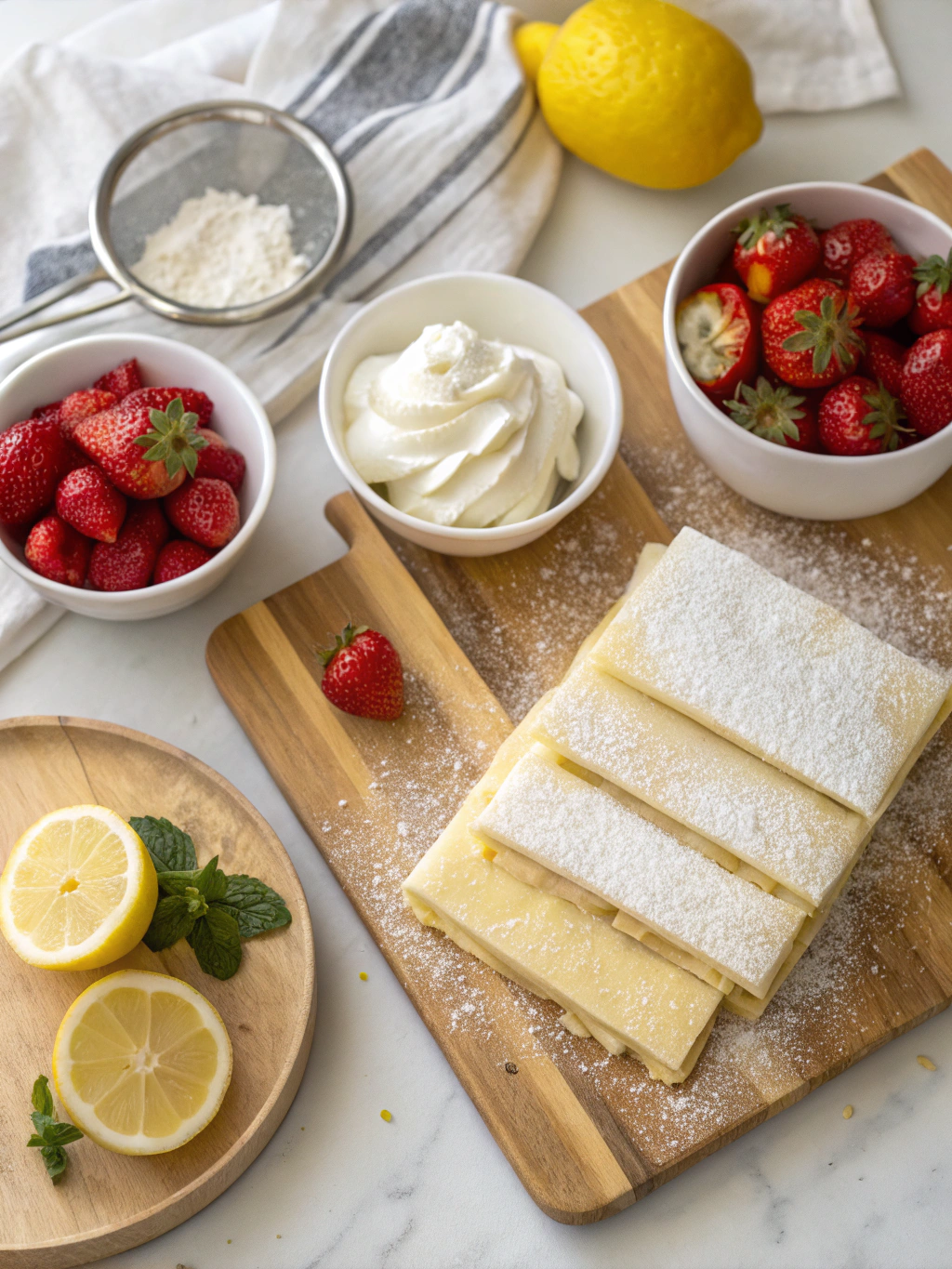
For the Pastry:
- 1 package (17.3 oz) all-butter puff pastry, thawed according to package directions
- 2 tablespoons confectioners’ sugar (for dusting)
For the Pastry Cream:
- 2 cups whole milk
- 1 vanilla bean, split lengthwise (or 2 teaspoons pure vanilla extract)
- 6 large egg yolks
- ⅔ cup granulated sugar
- ¼ cup cornstarch
- ¼ teaspoon salt
- 3 tablespoons unsalted butter, cut into small pieces
For the Icing:
- 1 cup confectioners’ sugar
- 2 tablespoons water
- 1 tablespoon unsalted butter, melted
- 1 tablespoon unsweetened cocoa powder
- 1 teaspoon hot water
For a lighter version, you can substitute the whole milk with 2% milk. If you’re short on time, high-quality store-bought puff pastry works wonderfully, though traditionalists might prefer making it from scratch for that authentic buttery flavor.
Timing
- Preparation Time: 45 minutes (plus 2 hours for chilling)
- Baking Time: 25 minutes
- Total Time: 3 hours 10 minutes
While this might seem lengthy compared to simpler desserts, the actual hands-on time is only about 60 minutes – 30% less than many other classic French pastries. Most of the time is passive chilling, which ensures perfect texture and flavor development.
Step-by-Step Instructions
Step 1: Prepare the Puff Pastry
Preheat your oven to 400°F (200°C). Line two baking sheets with parchment paper. Unfold the thawed puff pastry sheets on a lightly floured surface. Cut each sheet into three equal rectangles, giving you 6 pieces total.
Place the pastry rectangles on the prepared baking sheets, leaving space between each piece. Prick the pastry all over with a fork to prevent excessive puffing. Dust each rectangle lightly with confectioners’ sugar – this helps caramelize the pastry for extra crispness.
Step 2: Bake the Pastry
Cover each pastry rectangle with another sheet of parchment paper, then place a second baking sheet on top to weigh it down. This technique ensures even, flat layers rather than puffy ones.
Bake for 15 minutes, then remove the top baking sheet and parchment. Continue baking for another 8-10 minutes until the pastry is golden brown and crisp. Transfer to a wire rack and cool completely.
Step 3: Make the Pastry Cream
In a medium saucepan, heat the milk and vanilla bean (if using) until just simmering. Remove from heat and let steep for 10 minutes. If using vanilla extract instead, add it after cooking.
In a separate bowl, whisk together egg yolks, sugar, cornstarch, and salt until pale and thick. Gradually whisk about 1/2 cup of the hot milk into the egg mixture to temper it, then pour this mixture back into the remaining milk in the saucepan.
Cook over medium heat, whisking constantly, until the mixture thickens and begins to bubble, about 5-7 minutes. Continue cooking for 1 minute more. Remove from heat and whisk in the butter pieces until melted and incorporated.
Strain the pastry cream through a fine-mesh sieve into a clean bowl. Press plastic wrap directly onto the surface to prevent a skin from forming. Refrigerate until cold, at least 2 hours or overnight.
Step 4: Prepare the Icing
In a small bowl, mix the confectioners’ sugar with 2 tablespoons water and the melted butter until smooth. Transfer 1/3 of this mixture to another bowl and stir in the cocoa powder and hot water to make a chocolate icing.
Transfer the chocolate icing to a small piping bag or a plastic bag with a tiny corner snipped off. Set aside both icings until needed.
Step 5: Assemble the Mille-Feuille Pastry Recipe
Select the 3 most perfect pastry rectangles for the top and bottom layers. Place one rectangle on a serving platter. Whisk the chilled pastry cream until smooth, then spread half of it evenly over the pastry.
Top with a second pastry rectangle and spread with the remaining pastry cream. Place the third rectangle on top, pressing down very gently to secure the layers.
Step 6: Decorate
Spread the white icing evenly over the top pastry layer. While still wet, pipe thin parallel lines of chocolate icing across the white icing, spacing them about 1/2 inch apart.
Using a toothpick or the tip of a sharp knife, drag through the lines perpendicular to them, alternating directions (up, then down) every 1/2 inch to create the classic marbled effect. Allow the icing to set for about 15 minutes.
Step 7: Slice and Serve
For clean slices, use a very sharp knife and wipe it clean between cuts. For best results, refrigerate the assembled Mille-Feuille Pastry Recipe for 30 minutes before cutting to help the layers stay intact.
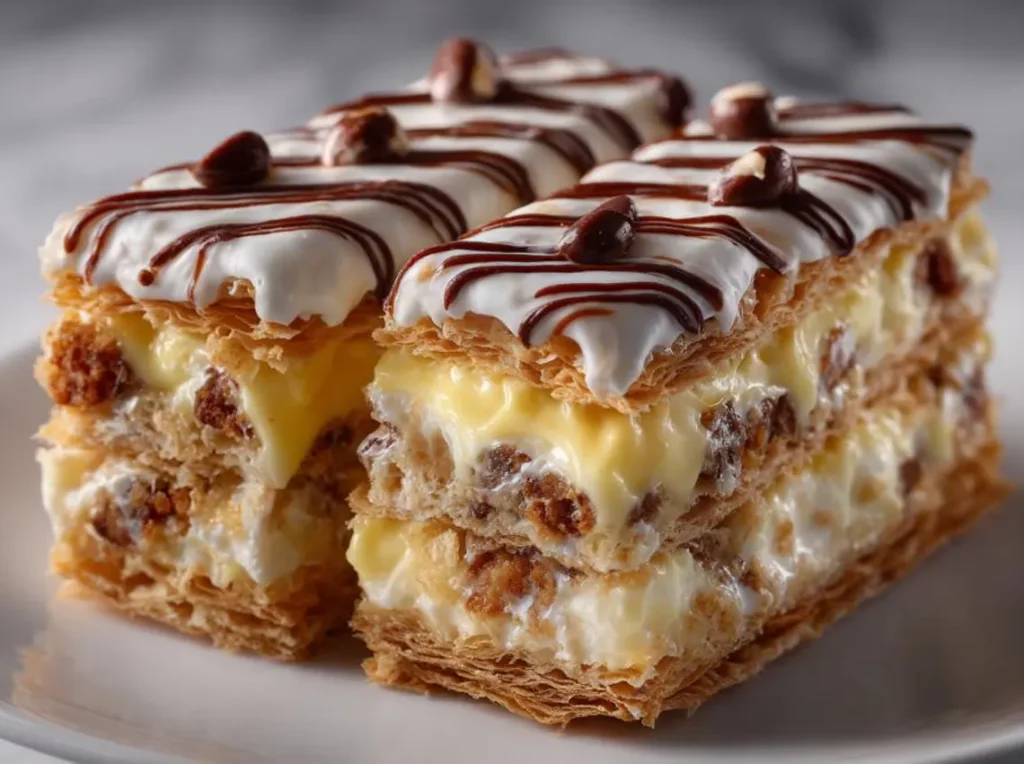
Nutritional Information
Per serving (1/8 of recipe):
- Calories: 420
- Fat: 26g (Saturated Fat: 12g)
- Cholesterol: 170mg
- Sodium: 230mg
- Carbohydrates: 42g (Dietary Fiber: 1g, Sugars: 24g)
- Protein: 7g
This dessert is undeniably an indulgence, with its rich buttery pastry and creamy filling. However, compared to many commercial bakery versions, this homemade recipe contains approximately 15% less sugar and no artificial preservatives or flavors.
Healthier Alternatives for the Recipe
For a lighter version of this classic Mille-Feuille Pastry Recipe, consider these modifications:
- Substitute whole milk with low-fat milk in the pastry cream to reduce fat content by about 30%
- Use Greek yogurt in place of half the pastry cream for added protein and reduced calories
- Incorporate fresh berries between the layers for added nutrients and natural sweetness
- Try a whole-grain puff pastry for additional fiber (though this will alter the traditional texture)
- Reduce sugar in the pastry cream by 25% and enhance flavor with extra vanilla or a touch of almond extract
For those with dietary restrictions, consider using plant-based milk and vegan butter alternatives for a dairy-free version, though the texture will differ slightly from the traditional recipe.
Serving Suggestions
Elevate your mille-feuille experience with these serving ideas:
- Pair with fresh berries and a light dusting of powdered sugar for an elegant presentation
- Serve alongside a small scoop of vanilla bean ice cream for a decadent dessert
- Accompany with a shot of espresso or a cup of Earl Grey tea to balance the sweetness
- For special occasions, add a drizzle of raspberry coulis or a sprinkle of edible gold dust
- Serve slightly chilled (about 15 minutes out of the refrigerator) for the perfect texture contrast between crisp pastry and creamy filling
Common Mistakes to Avoid
- Underbaking the pastry – Ensure your pastry is golden brown and completely crisp, or it will become soggy when filled
- Rushing the chilling time – Warm pastry cream will make assembly nearly impossible and result in a messy dessert
- Overwhipping the pastry cream – Stir just until smooth; excessive mixing can break down the structure
- Using a dull knife to cut – This compresses the layers instead of cleanly slicing through them
- Assembling too far in advance – The pastry will soften after about 4 hours; aim for no more than 2-3 hours before serving
- Making the icing too thin – It should be thick enough to stay in place but fluid enough to create the marbled pattern
Storing Tips for the Recipe
For best results, store assembled mille-feuille in the refrigerator for up to 24 hours. The pastry will gradually soften as it absorbs moisture from the cream, changing the texture but still remaining delicious.
You can prepare components separately ahead of time: the pastry cream keeps well for up to 3 days refrigerated in an airtight container with plastic wrap pressed directly on the surface. Baked pastry sheets can be stored at room temperature in an airtight container for 1-2 days.
For a make-ahead strategy, prepare all components separately and assemble just 1-2 hours before serving for the ideal texture balance between crisp and creamy.
Freezing assembled mille-feuille is not recommended as the texture significantly deteriorates upon thawing.
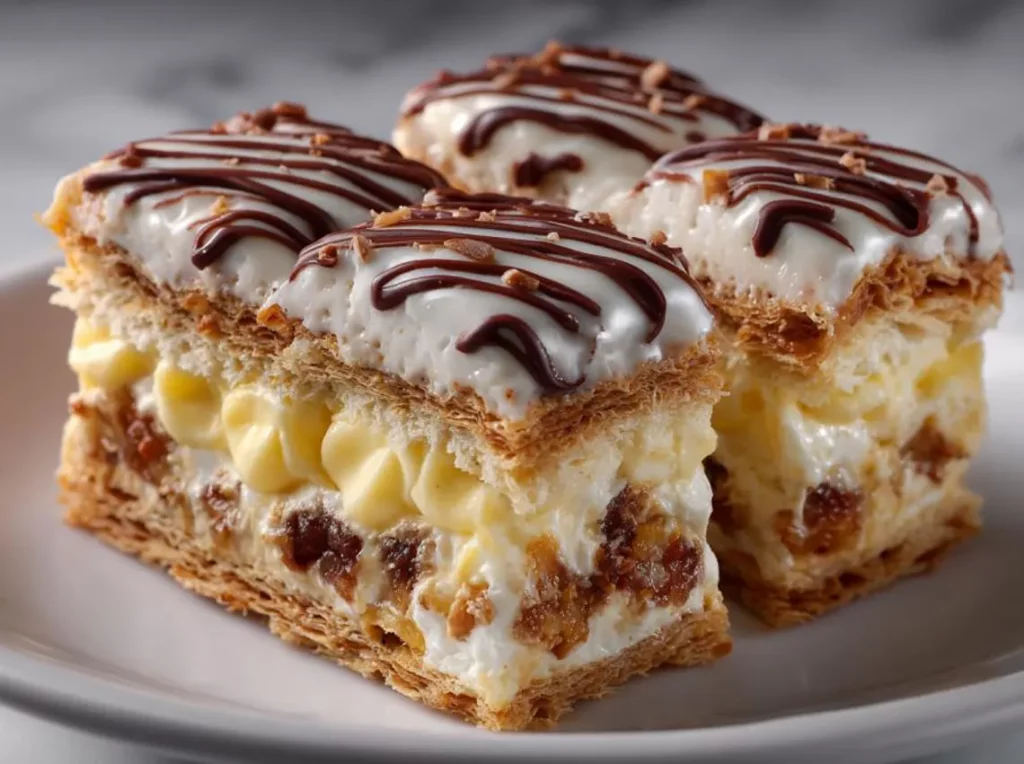
Conclusion
Mastering this classic Mille-Feuille Pastry Recipe is truly an achievement worth celebrating. While it requires some patience and attention to detail, the result is a professional-quality dessert that will impress even the most discerning guests.
The combination of crisp, buttery pastry and silky vanilla cream creates a textural symphony that exemplifies why French pastry has maintained its revered status throughout culinary history.
Have you tried making this elegant dessert at home? Share your experience in the comments below! And if you’re feeling inspired by French pastry, be sure to check out our other classic recipes like éclairs, madeleines, and Paris-Brest. Happy baking!


